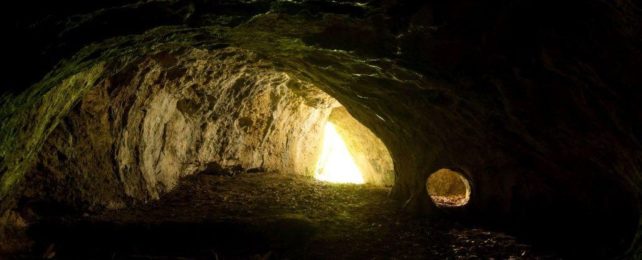 The entrance to Tunel Wielki cave. (Miron Bogacki/University of Warsaw)
The entrance to Tunel Wielki cave. (Miron Bogacki/University of Warsaw)
Prehistoric stone tools found in a cave in Poland 50 years ago were recentlyidentified as some of the oldest ever discovered in the region.
The tools from the Tunel Wielki cave in Małopolska are between 450,000 and 550,000 years old. This dating may allow scientists to learn more about the humans who made them, and their migration and habitation in Central Europe across prehistory.
For example, the timeframe likely means that the tools were made by extinct human species Homo heidelbergensis, usually considered the last common ancestor of Neanderthals and modern humans (us). And it means the region was inhabited by humans at a time that Central Europe’s harsh climate would have required significant physical and cultural adjustment.
“This is an extremely interesting aspect of analyses for us,” archaeologist Małgorzata Kot of the University of Warsaw in Poland explained to Science in Poland back in October 2022 when the research was released.
“We can examine the limits of the possibilities of survival of Homo heidelbergensis, and thus observe how he adapted to these adverse conditions.”
Tunel Wielki cave was excavated in the 1960s, with archaeologists returning again to the site in 2016. Layers of material were dated to the Holocone, dating back to around 11,700 years ago, and the Middle Paleolithic, stretching as far as 40,000 years ago.
But archaeologist Claudio Berto of the University of Warsaw thought the dating was at odds with what he was observing. Animal bones recovered from the site, he concluded, were almost certainly older than 40,000 years.
So, in 2018, Kot and her team returned to the cave. They reopened and extended one of the trenches, carefully examining the different layers of material accumulated over the years, and collecting more bone material to analyze.
They found that the upper layers did indeed contain the bones of animals that lived in the Late Pleistocene and the Holocene. But the bottom layer was distinctly older. It contained the bones of several species that lived half a million years ago: the European jaguar, Panthera gombaszoegensis; the Mosbach wolf, ancestor to modern gray wolves, Canis mosbachensis; and Deninger’s bear, Ursus deningeri.
The layer that yielded the bones also contained evidence of flint knapping, including flint flakes, the “blanks” from which other tools can be shaped, and the cores from which they are struck. There were also some finished tools, such as knives.
“Since these items come from the same layer as the bones, it means that their age is very similar,” Kot explained. “This assumption was confirmed by excavations carried out in the cave in 2018. They confirmed the arrangement of layers described by researchers half a century ago. We also discovered more production waste and animal bones.”
Previously, she added, there were only two known sites in Poland with tools from around the same time period: Trzebnica and Rusko. But the Tunel Wielki cave artifacts are different. Several archaeological sites in the area show evidence of ancient human habitation – but they are all open-air sites.
To find artifacts dating from that time in a cave is, according to Kot, very unexpected.
“We were surprised that half a million years ago people in this area stayed in caves, because those were not the best places to camp,” she noted.
“Moisture and low temperature would discourage that. On the other hand, a cave is a natural shelter. It is a closed space that gives a sense of security. We found traces that may indicate that the people who stayed there used fire, which probably helped tame these dark and moist places.”
Also of interest was the technique used to knap the flint found in the cave. This technique is the simplest used by ancient humans, and, at the time the tools were created, rarely used as a primary mode; usually, it was only used on poor-quality materials, or when flint was in short supply.
Only one other site, Isernia La Pineta in Italy, was using the technique as the primary one. The Tunel Wielki flint was not poor quality, nor was it scarce, being locally obtained. This was also the case for Isernia La Pineta; finding a second site with the same characteristics might help archaeologists work out the reason these ancient humans used that specific technique.
The team hopes to return to the cave to search for bones of Homo heidelbergensis.
